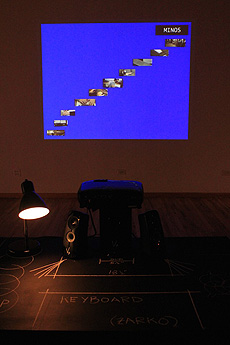Water Street Studios exhibit ties neutrino physics to human identity
 |
| Artist Meghan Beitiks makes physicists the objects of study through video projections of their daily tasks in patterns based on neutrino data sets. An exhibit of her work, based on interviews with Fermilab scientists, is on display at Water Street Studios in Batavia. Photo: Georgia Schwender, OC |
When artist Meghan Moe Beitiks came to Fermilab to explore the laboratory's neutrino projects and the physicists who pursue them, she left with an observation perhaps as elusive as the neutrino itself — a parallel between particle physics and human identity.
From Jan. 24 to March 7, Water Street Studios is hosting Beitiks' exhibit "Observations of Final States in Interactions," where she uses her experience at Fermilab to tie neutrinos, physicists' day-to-day activities and the philosophical concept of the self.
The exhibit provides a truly multimedia experience. Chalk drawings decorate the blackened windows and doors, videos are projected onto the walls, and voices of physicists and philosophers fill the air.
This project was born out of a conversation between Georgia Schwender, curator of the Fermilab Art Gallery, and Jen Evans, interim executive director at Water Street Studios. They spoke with Beitiks' curator, Ross Stanton Jordan, and when he approached Beitiks with the project, she was happy to accept.
"I was interested in the fact that a neutrino oscillates between different identities and that there are apparatuses to measure it," Beitiks explained. "They're defined by what they bump into — so what does that mean for the identity of the particle and for human concepts of identity?"
Neutrinos are extremely difficult to detect, and they oscillate between three different flavors: electron, muon and tau. In order to observe these oscillations, physicists at Fermilab shoot intense neutrino beams through detectors to spot their rare interactions with other particles. Researchers carry out these measurements in experiments such as MicroBooNE, MINERvA, MINOS+ and NOvA.
Beitiks integrates interviews with Mateus Carneiro da Silva, Bill Lee, Zarko Pavlovic and Sam Zeller, physicists working on these projects, in her installations to illustrate the commonalities between particle physics and identity.
This project became possible through a joint effort between Water Street Studios and Fermilab.
"Here are two institutions passionate about education and reaching out to the public about things that are important to them. There's no reason for us to not be doing it together," said Rita Grendze, the gallery director at Water Street.
Beitiks doesn't expect people to leave her exhibit understanding everything about neutrinos, but she hopes they'll begin to think about identity and particle physics.
"It's a simple installation, but I hope it induces complicated thinking,"
she said.
—Diana Kwon
Editor's note: Beitiks will be one of the speakers in the artist panel discussion at Water Street Studios on Saturday, Feb. 28, from 3 to 5 p.m.
|